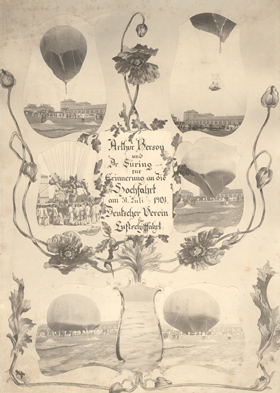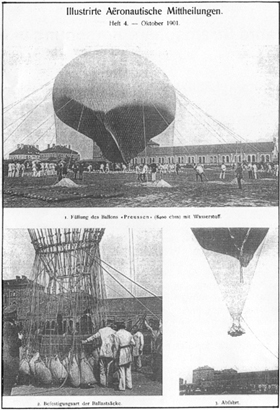

Extract from:
100 Years of Stratosphere Research in Berlin
by
Karin Labitzke und Barbara Naujokat
Berliner Wetterkarte 79/1, SO 30/01
100 years ago today at 11 am the balloon "Prussia", filled with 5400 cubic metres of hydrogen, rose into the air from the Tempelhofer Feld. On board this unusually large balloon were the most experienced and reliable of scientific balloonists, the departmental head of the Royal Meteorological Institute, Professor Reinhard Süring, and Professor Richard Aßmann's chief assistant, Dr Arthur Berson. In their report on this memorable ascent, Süring and Berson wrote:
"... After 40 minutes the balloon had reached a height of 5000 metres. It took until this height to assume its spherical shape. The temperature had sunk by over 30 degrees to minus 7 degrees. At between 5 and 6 km in height we began regularly to breathe oxygen. After about three hours we had reached a height of 8000 metres, after four hours 9000 metres. The influence of the air now thinned by one third due to atmospheric pressure and cooled to a temperature of minus 32 degrees centigrade was evidenced in an increased sleepiness. The last observation series covering both pressure and temperature was written down promptly and clearly at 10,225 metres. Soon after that we both fell into deep unconsciousness; Berson pulled the safety valve several times immediately beforehand, when he saw his companion (Süring) already asleep ... (Berson and Süring 1901)... ."
How dangerous an undertaking it was is shown by a fairly casual remark in Berson and Süring's report: "Before or after the safety valve was pulled, Süring, too, in lucid moments, tried to help his sleeping colleague to breathe more oxygen, but in vain. Presumably both voyagers finally lost their breathing tubes and sank into deep unconsciousness, from which they awoke more or less together at roughly 6000 metres ..."
The balloon was now falling swiftly. Only at about 2500 m did the two balloonists managed to stabilize it again, but were physically too weak to resume the instrumental observations. Süring and Berson landed at 6.25 p.m. in the Cottbus district. They were welcomed by a large crowd and spent the night at the house of a local parson. The next day the heavy equipment was recovered with the help of 30 men and transported back to Berlin.
The record height of 10,500 m (it may have been 10,800 m, but the ink froze, so that the barograph record was not considered a reliable document) for a manned open gondola was never broken. In 1927 the American Captain H. C. Gray travelled higher - according to his barograph which recorded 12,800 m - but did not survive the ascent.
This memorable balloon ascent by Süring and Berson, which became known throughout the world, brought the proof that measurements carried out using sounding balloons, for example on the same day, actually delivered reliable values. Thus research on the atmosphere could be carried out using the instruments developed Aßmann, without direct human help.
Aßmann had carried out a series of sounding balloon ascents between 1894 and 1897 and later commented "The very first ascents of this type brought some surprising indications and as early as the years 1894 to 1896 suggested to me - long before Teisserenc de Bort - the thought that an upper temperature inversion really occurs (above the tropopause - author's note)" (Aßmann 1915).
Aßmann introduced the use of rubber balloons, which had the particular advantage that their upward motion did not decrease with height, so that the measurement instruments were well ventilated even at great heights. He was exceptionally critical when it came to temperature measurements, since he had established that they were distorted by influence of sunlight. His rule was: "Build reliable instruments, and until we have got them, favour a single manned ascent over three ascents with sounding balloons" (Dubois 1955/1993).
The manned balloon ascent by Süring and Berson was so significant because direct comparison now enabled the measurements made by sounding balloons to be treated confidently. In collaboration with his friend and colleague Teisserenc de Bort, who had carried out similar balloon ascents from his private observatory in Trappes near Versailles and who had similarly been concerned about the distorting influence of sunshine on temperature results, the results which the two scientists had kept back for years were published in April/May 1902 and the discovery of the stratosphere was thus made known to the world (Aßmann 1902; de Bort 1902).
Aßmann's contemporaries agreed that it was an important, fruitful discovery. Thus Sir Napier Shaw in his 1926 Manual of Meteorology described the discovery of the stratosphere as "the most surprising discovery in the whole history of meteorology". Teisserenc de Bort now divided the atmosphere into two layers, which he named the troposphere and the stratosphere; the troposphere (tropos [Greek] = turning) being the layer that is characterized by swirling motion, and the stratosphere being that of (apparent) calm. Shaw added the term tropopause in 1926.
Literatur:
Aßmann, R., 1902: Über die Existenz eines wärmeren Luftstromes in der Höhe von 10 bis 15 km. Sitzungsbericht der Königlich-Preußischen Akademie der Wissenschaften zu Berlin, Sitzung der physikalisch-mathematischen Klasse vom 1. Mai 1902, XXIV, 1-10.
Berson, A und R. Süring, 1901: Ein Ballonaufstieg bis 10 500m. Illustrierte Aeronautische Mitteilungen, Heft 4, S. 117-119
Dubois, P., 1955/1993: Das Observatorium Lindenberg in seinen ersten 50 Jahren 1905-1955. Geschichte der Meteorologie in Deutschland, 1, Selbstverlag des Deutschen Wetterdienstes.
Labitzke, K., 1999: Die Stratospäre: Phänamene, Geschichte, Relevanz. 177 S., Springer Verlag Berlin Heidelberg New York.
Teisserenc de Bort, L.P., 1902: Variantions de la température de l'air libre dans la zona comprise entre 8km et 13km d'altitude. Compres Rendus de l'Acad. Sci. Paris, 134, 987-989.




